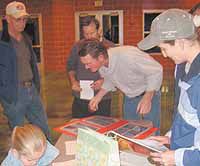| Local residents and club members attending the Castle Country Off-Highway Vehicle Association meeting last week study the design of the county’s proposed trail system. Representing the engineering firm of Jones and DeMille at the Nov. 17 gathering, Brian Barton gave the group an update of the progress of the planned trail. The firm has been hired by Carbon County in cooperation with the transportation and recreation special services district and the restaurant tax board to pioneer a 120-mile trail from Skyline Drive to Nine Mile Canyon. |
The Castle Country Off-Highway Vehicle Association met at the county fairgrounds on Nov. 17.
Representing the engineering firm of Jones and DeMille, Brian Barton gave the group an update of the progress of a new off-highway vehicle trail being planned for the county.
The engineering firm has been hired by Carbon County in cooperation with the Transportation and Recreation Special Services district and the Restaurant Tax Board to pioneer a 120-mile trail from skyline drive to Nine Mile Canyon.
Scott Wheeler, the OHV club specialist, introduced Barton to the group at last Thursday’s meeting.
Wheeler said he was encouraged by the spirit of cooperation between the OHV association, private landowners, Utah and county government and the United States Bureau of Land Management.
“Times have changed,” Wheeler told club members. “Everyone is finally working together on this.”
Wheeler said the OHV trail system will be an economic boost to the county and the state. He pointed to the success of the Piute and Arapeen OHV trails in central Utah and the tourist dollars the systems generate. He also talked about how having a designated trail system for outdoor recreation will help the BLM and forest service manage resources by allowing more control over the traffic.
“This trail system is a good thing for everyone,” Wheeler said.
Barton showed a map of the proposed trail system. He explained that the trail would begin at the Skyline Drive, drop down into Scofield, proceed south to Broad’s Canyon, across the ridge to Beaver creek and on to Consumer’s Wash.
From Consumer’s, the trail will pass through Helper and on to Kenilworth. From Kenilworth, it will follow various old roads and trails near the base of the mountains crossing Deadman Creek, Coal Creek, Soldier Creek, Dugout Creek, the northern part of Clark’s Valley and eventually head into East Carbon City.
From East Carbon, the trail will go through Sunnyside and up Whitmore Canyon to the top of Water Canyon, following the current road.
At the top of Water Canyon on Patmos Ridge, the trail will split with one option being the Dry Canyon road into Nine Mile and the other being the Cold Spring road into Cottonwood Canyon and the hunter pictograph panel.
The Patmos Ridge fork in the trail will make a loop at the bottom of Nine Mile Canyon, allowing riders to go down one road and come back on the other one.
In all, the trail is expected to be 110 to 120 miles long, depending on the final route designations.
Barton explained that the trail would be constructed using a small bulldozer. The trail will be 15 feet wide, big enough for two OHVs to pass going in opposite directions, and large enough to accommodate a full-sized four-wheel-drive vehicle for trail maintenance and emergency situations. He said that the plan is to have comfort stations placed at ten or twenty-mile intervals all along the trail. Some kiosks will also be built with photo exhibits, trail, and historical information.
It was explained that this trail could be the base for a series of add-on trails over the next several years, and that eventually the trail system might be much larger. Barton told the group that his focus is in the Scofield area at the present time, completing right-of-way agreements and engineer studies on the best routes. He said that things are on track for the entire project and he expects that construction will begin in the spring of 2006. He said the trail could be completed before next winter.
After the presentation, members of the OHV club talked about the need for club members to do all they can to help by volunteering their time and means, and by doing good-will rides where they help to keep the trail system clean and in good repair. They also talked about doing all they can to educate other OHV riders to be responsible users of the pubic lands.
The Castle Country OHV Association meets the third Thursday of each month at seven p.m. in the multi-purpose room at the county fairgrounds. Annual dues are $25.00 per household. The group does monthly trail rides and the club offers great opportunities for outdoor family recreation. For more information, contact Scott Wheeler, Mike Stout, Alan Peterson, or David Hussey.

